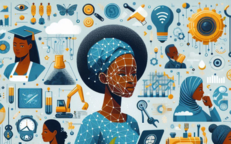Gendering Agriculture: Empowering African Women Farmers Using Modern Technologies

This is the 18th post in a blog series to be published in 2021 by the Secretariat on behalf of the AU High-Level Panel on Emerging Technologies (APET) and the Calestous Juma Executive Dialogues (CJED)
The Africa Union's Agenda 2063 and United Nation's Sustainable Development Goals (SDGs) aspire for food security and gender equality in Africa's agriculture.[1] This is to ensure that gender equality results in lucrative and fair compensation and improve efforts to alleviate poverty, more especially across gender lines.
Notably, women account for approximately 43% of the agricultural labour force in developing countries.[2] Furthermore, women account for 50% of the agricultural workforce in most Eastern and Southern African countries.[3] Despite women's dominance and significant contributions towards agribusiness activities, the productivity divide between men and women farmers persist across the African continent.
African women farmers have been reported to receive meagre harvest and compensation from agricultural activities.[4] This is not only occurring because of incremental climate changes, unpredictable weather conditions, and poor soil quality but gender inequality. Currently, even though there have been efforts to address such inequalities and subsequent negative impacts, there remains numerous limiting legislative laws and regulatory systems and policy frameworks. As such, the agribusiness implementation programmes, culture, and customs render women in agriculture significantly disadvantaged in several African countries.[5]
Farming in Africa is a daunting task, not just for women but also men. However, African women are more vulnerable within the agricultural ecosystem because of the unfavourable gender divide. Some systematic and legislative gender divide frameworks are negatively impacting women's agricultural outputs. For example, some women in Africa are challenged because of their inability to legally or customarily own land. In some cultures, African women farmers cannot own land due to patriarchal inclining policy, legislative, and regulatory frameworks on Africa's land ownership. Such women struggle to persuade willing landowners to sell them land and accompanying resources and, as a result, can only lease the land. Unfortunately, under such circumstances, women cannot invest in long-term agricultural activities such as fruits and trees that require longer periods to mature and sell in local and international markets.
Furthermore, Africa's women, more especially rural smallholder farmers, have limited access to reliable financial and banking facilities. There have been reports that some African financial and banking institutions are not women-friendly and hardly afford women with loan instruments and facilities. For example, the financial access of women remains disproportionately low worldwide. Despite substantial overall progress over the last decades, the World Bank reported that in 2017, approximately 1.2 billion more people had bank accounts than in 2011.[6] However, there is still a 9% gap between women's and men's access to financial instruments. Within sub-Saharan Africa, only 37% of women have bank accounts, compared to approximately 48% of counterpart men.[7] This banking gap has only widened over the past several years. These trends are worse in North Africa, where approximately two-thirds of the adult population remains unbanked. The gender gap on access to finance is 18%, which is the largest gender divide in the world.[8] Unfortunately, when collateral is required, women farmers have limited assets, if any, to ascertain collateral when acquiring loan instruments within financial institutions.
Productive farming requires reliable and sustainable transportation and tractors, fertilisers, pesticides and herbicides, among other agrarian inputs. As these are cost-intensive, without adequate funding mechanisms, they cannot be procured. Consequently, some women struggle to maximise their agricultural output and subsequent compensation.
The lack of agricultural extension services has also negatively contributed to the limited farming outputs among women in rural Africa. In the past, agricultural extension services have been extensively utilised towards training rural farmers on best agribusiness practices. Such efforts have significantly improved outputs in the past. That means, reducing such efforts negatively impacts rural agribusiness practices, outputs, and outcomes. On the other, when undertaking agricultural extension services and having adequately trained farming women, they would still lack relevant equipment and facilities to enable farming practices within rural African areas. In addition, the lack of access to markets has also negatively impacted farming outputs for African women. As such, the deteriorating, and in some cases, non-existent road infrastructure in most African countryside, rural farmers can barely transport their products to the markets on time.
The African Union Panel on Innovation and Emerging Technologies (APET) encourages African countries to incorporate emerging technologies and innovation to address the gender gap. For instance, incorporating emerging technologies into women's farming activities can significantly upsurge access to markets and financial instruments, irrespective of the farmers' gender. Emerging technologies such as digital, artificial intelligence, and robotics technologies can improve agro-processing value addition. Cooling technologies such as charcoal cool storage facilities can reduce food wastages. Furthermore, canning technologies can enhance the preservation and shelf-life of products. Thus, access to innovation and emerging technologies can improve agricultural productivity and efficiency for rural and smallholder farmers, irrespective of gender.
African countries such as Tanzania, Malawi, and Uganda have put in place efforts aimed at narrowing the gender gap in their agricultural productivity. Such efforts have improved these countries' Gross Domestic Product (GDP) by approximately US$105 million, US$100 million, and US$65 million, respectively.[9] Such GDP improvements clearly indicate that African countries are required to address the imperative policy and infrastructural support suitable for alleviating gender inequality.
There have also been positive strides within African countries to afford rural smallholder farmers access to digital agriculture. For example, Rwanda's initiative called "buy-from-women" has encouraged adopting digital agriculture technologies to increase access to markets for African women farmers. This project has sought to create digital-enabled platforms that connect women farmers to agribusiness information, financial instruments, and produce markets. Consequently, through this initiative, women farmers have improved their entire agribusiness lifecycle[10].
Kenyan women farmers have adopted an effective utilisation of digital technologies from their smartphones to access weather-related information and weather trends. This information allows women farmers predict suitable planting seasons and harvest times, more especially concerning the crops that require drying.[11] Furthermore, the Uganda Network is working with women farmers to enhance rice-green gram productivity. In addition, African farmers are being trained to profile their crop data details using digital technologies. Within this framework, African farmers are mapping their gardens and fields to engage with technical agrarian experts and search for markets. Digital technologies also support transportation and tracking of crops to markets, marketing and sales, and direct payment regimes. These technologies are also building on women's strengths in indigenous knowledge of local and organic crops. As digital technologies enable women farmers to have better access to premium markets, they can also facilitate the certification processes and enable digital-based solutions suitable for managing delivery chain logistics.
In conclusion, reducing the gender divide within African farmers using digital agriculture remains critical. Therefore, African countries are encouraged to address the persistent and systematic inequalities and infrastructural, policy, and strategic frameworks that disproportionately impact women's contribution to Africa's agricultural and food security systems using technological and innovative resources. Such strategic frameworks can improve agribusiness opportunities, socio-economic development and alleviate hunger and poverty. Thus, incorporating women's participation in the digitalisation of Africa's agriculture is a prerequisite for the continent to achieve the aspirations of Agenda 2063: "The Africa We Want".
Featured Bloggers – APET Secretariat
Justina Dugbazah
Barbara Glover
Bhekani Mbuli
Chifundo Kungade
[1] https://au.int/en/agenda2063/sdgs.
[2] http://www.fao.org/3/i2050e/i2050e02.pdf.
[3] http://www.fao.org/3/x0198e/x0198e02.htm.
[4] http://www.fao.org/3/i5251e/i5251e.pdf.
[5] https://www.ifpri.org/blog/empowering-africas-women-farmers.
[6] https://www.worldbank.org/en/news/press-release/2018/04/19/financial-inclusion-on-the-rise-but-gaps-remain-global-findex-database-shows.
[7] https://www.imf.org/external/pubs/ft/fandd/2020/03/africa-gender-gap-access-to-finance-morsy.htm.
[8] Sharon Chen, Sebastian Doerr, Jon Frost, Leonardo Gambacorta, Hyun Song Shin, BIS Working Papers, No 931, The fintech gender gap, Monetary and Economic Department, March 2021. https://www.bis.org/publ/work931.pdf.
[9] https://www.empowerwomen.org/en/circles/open-discussion-about-laws-and-policies-to-advance-womens-economic-empowerment/~/media/1c39debdcbfe44dc95a0fd1875c5d649.ashx.
[10] http://www.fao.org/e-agriculture/news/women-agriculture-and-icts
[11] http://www.fao.org/climate-smart-agriculture-sourcebook/production-resources/module-b1-crops/b1-overview/en/?type=111.


